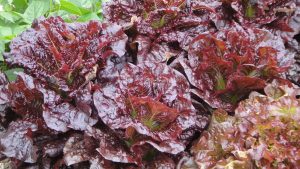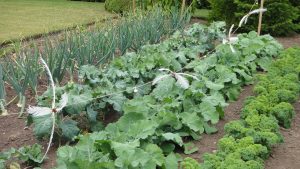Fall is an excellent time to grow many vegetable crops in Indiana when the gardener can take advantage of cooler temperatures and more plentiful moisture. Fall gardening helps extend your gardening season so that you can continue to harvest produce after earlier crops have faded.
Many vegetable crops are well adapted to planting in late summer for a fall harvest. Early spring-planted crops such as radishes, lettuce and spinach tend to bolt (produce seed) and become bitter in response to hot summer weather. So now is the time to replant and take advantage of the shorter cooler days to come. Broccoli, cauliflower and Brussels sprouts are also well adapted to fall gardening; they produce best quality and flavor when they can mature during cooler weather. For many crops, insect and disease pests may not pose as much of a problem in fall plantings.
However, it is hard to know just how many weeks of good, fall, growing weather we will have in any given year. In much of Indiana, the first 32 degrees F frost date usually falls sometime in mid to late October, but it can also come in September. Look up the fall frost dates for your area at http://www.crh.noaa.gov/images/ind/freezedates_32.png.
Use fast-maturing cultivars whenever possible to ensure a harvest before killing frost occurs. Check with your local garden centers for available plants and seed. Or if you order by mail, keep the fall garden in mind while planning your spring order for garden seeds. Seeds of the cultivars you want may be out of stock by late summer.
To prepare your garden for a fall crop, remove previous crop residue and weeds. If needed, till or spade about 6-8 inches deep to loosen soil. If the soil has been heavily cropped, you may need to apply additional fertilizer, but you likely can get by with just a light application of nitrogen unless a soil test indicates the need for additional potassium and phosphorus.
Late summer plantings often suffer from hot soil and/or lack of water. Soils may form a hard crust over the seeds, which can interfere with seed germination, particularly in heavy soils. Use a light mulch of compost or vermiculite over the seed row to prevent a crust from forming. Seeds of lettuce, peas and spinach, in particular, do not germinate well when soil is 85 degrees F and above – shading over the seed row may help.
Do not allow seedlings and young transplants to dry out excessively. Apply 1 inch of water in a single application each week to thoroughly moisten the soil, if rainfall is inadequate. Young seedlings may need to be watered more often during the first week or two of growth. Young transplants may benefit from light shade for the first few days until their new roots become established.
Indiana often enjoys several more weeks of good growing after the first frost. You can extend the fall growing season for tender crops by protecting them through early, light frosts. Cover growing beds with blankets or throw-cloths supported by stakes or wire to prevent mechanical injury to the plants. Individual plants can be protected with such items as paper caps, milk jugs, plastic water-holding walls and other commercially available products.
Some vegetables that are already growing in the garden will continue to produce well into the fall but are damaged by even a light frost. Some crops are considered semi-hardy and will withstand a light frost without protection. Others are hardy enough to withstand several hard frosts. Many common vegetables are listed below, according to their frost tolerance.
Cold Temperature Tolerance of Vegetables
| Tender Vegetables | Semi-Hardy Vegetables | Hardy Vegetables |
| (damaged by light frost) | (tolerates light frost) | (tolerates hard frost) |
| Beans | Beets | Broccoli |
| Cucumber | Carrot | Brussels Sprouts |
| Eggplant | Cauliflower | Cabbage |
| Muskmelon | Celery | Collards |
| New Zealand Spinach | Chard | Kale |
| Okra | Chinese Cabbage | Kohlrabi |
| Pepper | Endive | Mustard Greens |
| Pumpkin | Lettuce | Onion |
| Squash | Parsnip | Parsley |
| Sweet Corn | Potato | Peas |
| Sweet Potato | Salsify | Radish |
| Tomato | Spinach | |
| Watermelon | Turnip |

